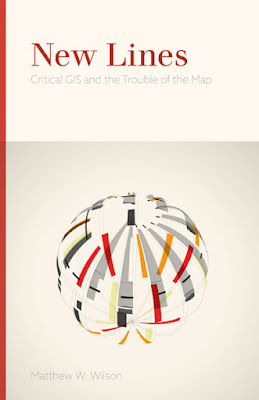Critical Physical Geography in Practice: AAG NYC 2012
I hope this AAG session will help to explore the overlapping concerns between critical technological practice and an emerging 'critical physical geography'.
Call for Papers: Critical Physical Geography in Practice
Association of American Geographers Annual Meeting
24-28 February 2012
New York, NY
Organizers:
Rebecca Lave (Indiana University)
James Porter (Kings College London)
Matthew W. Wilson (University of Kentucky)
Calls to reintegrate physical and human geography have been a common theme in Anglophone Geography for decades. Thanks to sustained work by David Demeritt, Doreen Massey, Keith Richards, Bruce Rhoads, and Nigel Thrift, among many others, the dream of a transdisciplinary bridge within Geography has persisted, even as the chasm it must span appears to be widening (Thrift 2002). Happily, that bridge is more than a dream: it supports increasing amounts of traffic as a growing number of geographers commute across it daily, combining critical social theory and deep knowledge of a particular field of biophysical science or technology in the service of social and environmental change.
This transdisciplinary commute, which we term Critical Physical Geography, brings notable benefits to scholars on both sides of the bridge, opening up new funding opportunities, offering innovative combinations of methods, and justifying Geography’s place in the modern world. By drawing environmental science and technology into their analyses, human geographers strengthen the material basis and credibility of their work, while gaining greater access to policy debates that affect their research sites. Applying critical perspectives from historical-materialism, feminism, and STS (among other bodies of theory) in the biophysical sciences and GIS, enables physical geographers to deepen their understanding of, and ability to address, the social, cultural and political-economic forces that shape their institutional settings and field sites, as well as the policy implications of their work.
As witnessed by the continuing calls for transdisciplinary research, the scholarship that falls under the Critical Physical Geography rubric has received little attention as a collective body of work. We hope to change that.
Our proposed panel sessions thus have two primary goals: to lay out the basic characteristics of Critical Physical Geography as it is currently practiced, and to develop a shared research agenda. In the first session, we will ask panelists to address key questions about their transdisciplinary practice, such as:
o What (or who) does the transdisciplinary bridge connect: institutions, individual scholars, particular strands of Geography?
o What are the primary factors that enable current transdisciplinary work? What are the main obstacles and sources of friction?
o Does the traffic tend to move in one direction more than the other? If so, why?
o What's motivating the surge of interest in crossing the bridge?
o What topics, methods, and theoretical framings have been productive in transdisciplinary practice?
In the second session, we will ask panelists to draw on the presentations from the first session and their own work to begin to lay out a shared set of practical and theoretical commitments, and an agenda for future Critical Physical Geography research.
Please contact Rebecca Lave (rlave@indiana.edu) by August 1, 2011.
Call for Papers: Critical Physical Geography in Practice
Association of American Geographers Annual Meeting
24-28 February 2012
New York, NY
Organizers:
Rebecca Lave (Indiana University)
James Porter (Kings College London)
Matthew W. Wilson (University of Kentucky)
Calls to reintegrate physical and human geography have been a common theme in Anglophone Geography for decades. Thanks to sustained work by David Demeritt, Doreen Massey, Keith Richards, Bruce Rhoads, and Nigel Thrift, among many others, the dream of a transdisciplinary bridge within Geography has persisted, even as the chasm it must span appears to be widening (Thrift 2002). Happily, that bridge is more than a dream: it supports increasing amounts of traffic as a growing number of geographers commute across it daily, combining critical social theory and deep knowledge of a particular field of biophysical science or technology in the service of social and environmental change.
This transdisciplinary commute, which we term Critical Physical Geography, brings notable benefits to scholars on both sides of the bridge, opening up new funding opportunities, offering innovative combinations of methods, and justifying Geography’s place in the modern world. By drawing environmental science and technology into their analyses, human geographers strengthen the material basis and credibility of their work, while gaining greater access to policy debates that affect their research sites. Applying critical perspectives from historical-materialism, feminism, and STS (among other bodies of theory) in the biophysical sciences and GIS, enables physical geographers to deepen their understanding of, and ability to address, the social, cultural and political-economic forces that shape their institutional settings and field sites, as well as the policy implications of their work.
As witnessed by the continuing calls for transdisciplinary research, the scholarship that falls under the Critical Physical Geography rubric has received little attention as a collective body of work. We hope to change that.
Our proposed panel sessions thus have two primary goals: to lay out the basic characteristics of Critical Physical Geography as it is currently practiced, and to develop a shared research agenda. In the first session, we will ask panelists to address key questions about their transdisciplinary practice, such as:
o What (or who) does the transdisciplinary bridge connect: institutions, individual scholars, particular strands of Geography?
o What are the primary factors that enable current transdisciplinary work? What are the main obstacles and sources of friction?
o Does the traffic tend to move in one direction more than the other? If so, why?
o What's motivating the surge of interest in crossing the bridge?
o What topics, methods, and theoretical framings have been productive in transdisciplinary practice?
In the second session, we will ask panelists to draw on the presentations from the first session and their own work to begin to lay out a shared set of practical and theoretical commitments, and an agenda for future Critical Physical Geography research.
Please contact Rebecca Lave (rlave@indiana.edu) by August 1, 2011.



Comments
Post a Comment